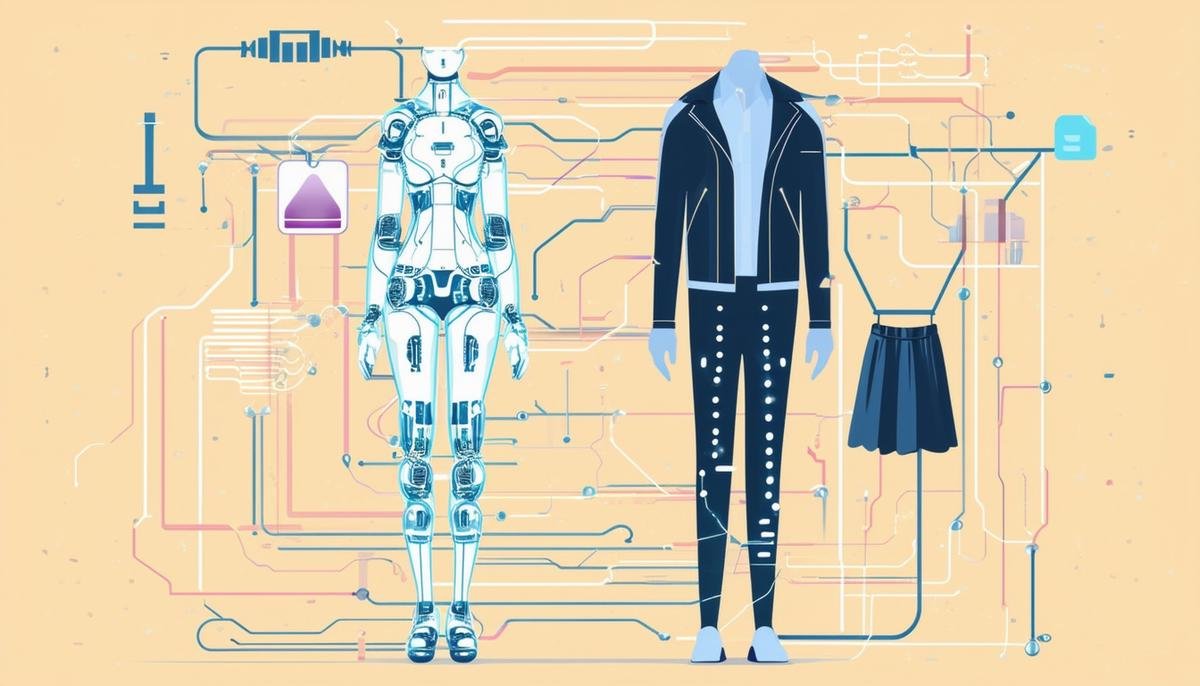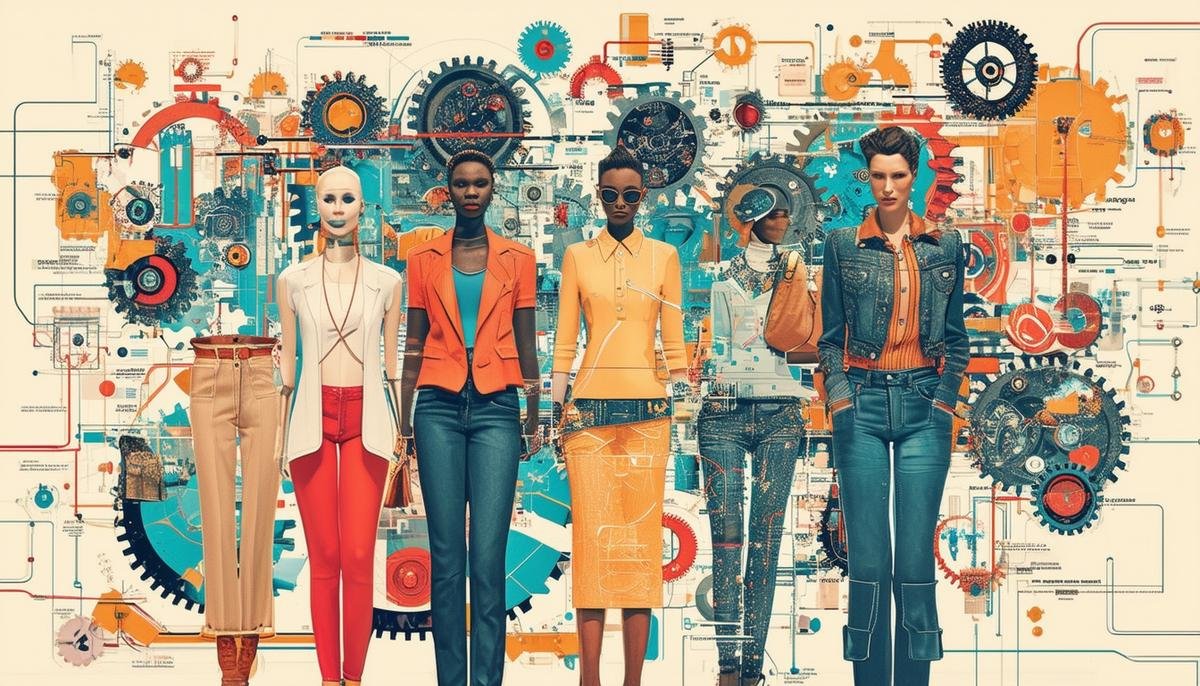Leveraging Generative AI for Personalized Styling
Stitch Fix combines human intuition and machine intelligence to elevate clothing recommendations. Utilizing OpenAI’s large language models like GPT-4 and in-house deep learning algorithms, Stitch Fix interprets textual client feedback to comprehend style preferences and produce accurate recommendations. This streamlines the process for stylists, allowing them to focus on fine-tuning selections.
Generative AI is essential for creating content like ad copy and product descriptions. GPT-3 generates compelling, relevant ad copy and detailed descriptions within seconds, which human experts then review for quality and accuracy before implementation. This drastically reduces preparation time, enabling Stitch Fix’s advertising agility and scalable product description writing.
Stitch Fix’s AI innovation in Outfit Creation stands out. The Outfit Creation Model (OCM) uses generative AI to propose millions of outfit ideas daily, considering real-time inventory and customer history. This offers a dynamic shopping experience, showing how new items integrate into existing wardrobes.

Automating Text Generation for Marketing and Product Descriptions
Stitch Fix employs GPT-3 to generate engaging ad copy and informative product descriptions, significantly boosting efficiency. In online marketing, GPT-3 performs the task of producing compelling, accurate ad content using predefined style keywords and product attributes. Human copywriters then ensure the AI-generated text meets quality standards, maintaining the brand’s voice and integrity.
The same streamlined process applies to product descriptions. By training GPT-3 on existing content and nuanced client feedback, Stitch Fix has created an efficient system capable of drafting thousands of product descriptions rapidly. These descriptions are:
- Concise
- Informative
- Tailored to reflect each item’s unique attributes and appeals
Human reviewers ensure these AI-generated descriptions are accurate and engaging, sustaining customer trust and satisfaction.

Outfit Creation Model (OCM)
The Outfit Creation Model (OCM) is a prime example of Stitch Fix leveraging AI to enhance its service. OCM uses generative AI to suggest millions of outfit combinations daily, tailored to individual preferences. Trained on vast datasets including current inventory and historical purchase data, OCM provides clients with outfit ideas that seamlessly integrate new and existing wardrobe items.
OCM analyzes a client’s style preferences, past purchases, and current inventory, generating around 13 million new outfit combinations daily. These AI-generated outfits are displayed through various touchpoints like personalized emails and shopping feeds, providing a curated, immersive shopping experience.
By continually updating outfit suggestions, OCM transforms the entire client experience. Clients gain confidence mixing and matching pieces, potentially exploring new styles. With the vast volume of personalized recommendations, fashion inspiration is at their fingertips, making online shopping enjoyable and efficient.

Balancing Human Expertise and Machine Intelligence
Stitch Fix strikes a balance between automation and human skills, resulting in an efficient yet deeply personalized service. While AI leads in automating repetitive tasks, human touch adds crucial creativity and judgment required to finalize recommendations and build genuine client relationships.
AI algorithms streamline routine processes, making initial recommendations that considerably reduce stylist workload. This computational power ensures stylists no longer manually review extensive client histories. By handling time-consuming tasks, AI allows human experts to engage more meaningfully with clients.
Yet, human stylists remain indispensable. While machines rapidly analyze data and suggest items, humans understand nuanced preferences and evolving fashion sensibilities of each client. Human stylists review AI-generated recommendations, adding insights to refine selections, ensuring recommendations resonate deeply with clients.
Human creativity and judgment also play a crucial role in curating unique, stylish outfits. While OCM provides a foundation by generating outfit possibilities, human intervention perfects these combinations with distinctive flair. Stylists employ fashion expertise to tweak AI-suggested outfits, making adjustments based on their understanding of trends and client tastes.
The human element is vital in maintaining and building client relationships. While AI automates communication significantly, it can’t replicate empathy and interpersonal skills required for lasting bonds. Stylists interact directly with clients, listening to preferences, understanding concerns, and offering tailored advice beyond algorithmic suggestions. These interactions build trust and loyalty, making clients feel valued and understood personally.
Overall, Stitch Fix exemplifies an effective partnership between automation and human skills driving superior outcomes. By leveraging AI for data processing and initial recommendations, Stitch Fix empowers its human team to focus on creativity, intuition, and relationship-building. This balanced approach enhances operational efficiency while elevating the overall client experience.

Future Prospects of Generative AI in Fashion
The future of generative AI in fashion is promising, with potential to revolutionize various industry aspects further. Deeper personalization is one frontier where generative AI is set to make a substantial impact. As models become more sophisticated, they will understand and predict client preferences with greater nuance beyond simple style and fit recommendations. Future AI systems could consider a client’s lifestyle changes and adjust fashion suggestions accordingly.
Enhancing stylist-client interactions is another area for innovation. While AI handles many automated tasks, generative AI can support stylists in crafting personalized messages or responses, ensuring timely and resonant communication with each client’s needs. Real-time sentiment analysis during these interactions could provide insights into client satisfaction, allowing stylists to promptly address concerns effectively.
Stitch Fix exemplifies continuous experimentation and innovation with generative AI. One exciting possibility is virtual try-ons, where AI could create highly accurate 3D avatars of clients based on their measurements and style data, allowing visualization of how different outfits would look before purchase.
Generative AI could also play a role in sustainability by predicting which styles and products are likely to see long-term popularity, helping brands make more sustainable production choices and reducing waste.
The possibilities are vast, from trend prediction and deeper personalization to enhancing stylist-client interactions and promoting sustainability. With companies like Stitch Fix leading the charge, advanced AI integration will likely set new standards for personalized shopping experiences and operational excellence.

- Rosenbaum E, Case A. The generative AI revolution: the implications for fashion and beauty. McKinsey & Company. 2022.
- Stitch Fix. Stitch Fix Annual Report. 2022.
- Vaidyanathan S, Schuler M, Stich C. Stitch Fix: Machine Learning for Personalized Style Recommendations. Harvard Business Review. 2021.




